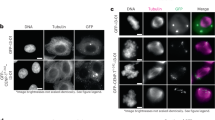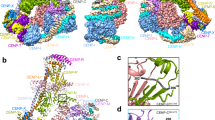Abstract
Kinetochores are large multiprotein complexes that mediate chromosome segregation in all eukaryotes by dynamically connecting specialized chromosome regions, termed centromeres, to the plus-ends of spindle microtubules1,2. Even the relatively simple kinetochores of the budding yeast Saccharomyces cerevisiae consist of more than 80 proteins, making analysis of their respective roles a daunting task3. Here, we have developed a system that allows us to artificially recruit proteins to DNA sequences and determine whether they can provide any aspect of kinetochore function in vivo. We show that artificial recruitment of the microtubule-binding Dam1 complex to a plasmid lacking any centromere DNA is sufficient to confer mitotic stabilization. The Dam1-based artificial kinetochores are able to attach, bi-orient and segregate mini-chromosomes on the mitotic spindle, and they bypass the requirement for essential DNA-binding components of natural kinetochores. Thus, we have built a simplified chromosome segregation system by directly recruiting a microtubule force-transducing component to DNA.
This is a preview of subscription content, access via your institution
Access options
Subscribe to this journal
Receive 12 print issues and online access
$209.00 per year
only $17.42 per issue
Buy this article
- Purchase on Springer Link
- Instant access to full article PDF
Prices may be subject to local taxes which are calculated during checkout




Similar content being viewed by others
References
Cheeseman, I. M. & Desai, A. Molecular architecture of the kinetochore-microtubule interface. Nature Rev. Mol. Cell Biol. 9, 33–46 (2008).
Tanaka, T. U. & Desai, A. Kinetochore-microtubule interactions: the means to the end. Curr. Opin. Cell Biol. 20, 53–63 (2008).
Westermann, S., Drubin, D. G. & Barnes, G. Structures and functions of yeast kinetochore complexes. Annu. Rev. Biochem. 76, 563–591 (2007).
Meluh, P. B., Yang, P., Glowczewski, L., Koshland, D. & Smith, M. M. Cse4p is a component of the core centromere of Saccharomyces cerevisiae. Cell 94, 607–613 (1998).
Furuyama, S. & Biggins, S. Centromere identity is specified by a single centromeric nucleosome in budding yeast. Proc. Natl Acad. Sci. USA 104, 14706–14711 (2007).
Clarke, L. & Carbon, J. Isolation of a yeast centromere and construction of functional small circular chromosomes. Nature 287, 504–509 (1980).
Megee, P. C. & Koshland, D. A functional assay for centromere-associated sister chromatid cohesion. Science 285, 254–257 (1999).
Dewar, H., Tanaka, K., Nasmyth, K. & Tanaka, T. U. Tension between two kinetochores suffices for their bi-orientation on the mitotic spindle. Nature 428, 93–97 (2004).
Cheeseman, I. M., Chappie, J. S., Wilson-Kubalek, E. M. & Desai, A. The conserved KMN network constitutes the core microtubule-binding site of the kinetochore. Cell 127, 983–997 (2006).
Ciferri, C. et al. Implications for kinetochore-microtubule attachment from the structure of an engineered Ndc80 complex. Cell 133, 427–439 (2008).
Cheeseman, I. M. et al. Implication of a novel multiprotein Dam1p complex in outer kinetochore function. J. Cell Biol. 155, 1137–1145 (2001).
Cheeseman, I. M. et al. Phospho-regulation of kinetochore-microtubule attachments by the Aurora kinase Ipl1p. Cell 111, 163–172 (2002).
Tanaka, K., Kitamura, E., Kitamura, Y. & Tanaka, T. U. Molecular mechanisms of microtubule-dependent kinetochore transport toward spindle poles. J. Cell Biol. 178, 269–281 (2007).
Miranda, J. J., De Wulf, P., Sorger, P. K. & Harrison, S. C. The yeast DASH complex forms closed rings on microtubules. Nature Struct. Mol. Biol. 12, 138–143 (2005).
Westermann, S. et al. Formation of a dynamic kinetochore-microtubule interface through assembly of the Dam1 ring complex. Mol. Cell 17, 277–290 (2005).
Wang, H. W. et al. Architecture of the Dam1 kinetochore ring complex and implications for microtubule-driven assembly and force-coupling mechanisms. Nature Struct. Mol. Biol. 14, 721–726 (2007).
Westermann, S. et al. The Dam1 kinetochore ring complex moves processively on depolymerizing microtubule ends. Nature 440, 565–569 (2006).
Asbury, C. L., Gestaut, D. R., Powers, A. F., Franck, A. D. & Davis, T. N. The Dam1 kinetochore complex harnesses microtubule dynamics to produce force and movement. Proc. Natl Acad. Sci. USA 103, 9873–9878 (2006).
Grishchuk, E. L. et al. The Dam1 ring binds microtubules strongly enough to be a processive as well as energy-efficient coupler for chromosome motion. Proc. Natl Acad. Sci. USA 105, 15423–15428 (2008).
Cheeseman, I. M., Enquist-Newman, M., Muller-Reichert, T., Drubin, D. G. & Barnes, G. Mitotic spindle integrity and kinetochore function linked by the Duo1p/Dam1p complex. J. Cell Biol. 152, 197–212 (2001).
He, X., Rines, D. R., Espelin, C. W. & Sorger, P. K. Molecular analysis of kinetochore-microtubule attachment in budding yeast. Cell 106, 195–206 (2001).
Shcheprova, Z., Baldi, S., Frei, S. B., Gonnet, G. & Barral, Y. A mechanism for asymmetric segregation of age during yeast budding. Nature 454, 728–734 (2008).
Sandall, S. et al. A Bir1-Sli15 complex connects centromeres to microtubules and is required to sense kinetochore tension. Cell 127, 1179–1191 (2006).
Garner, E. C., Campbell, C. S. & Mullins, R. D. Dynamic instability in a DNA-segregating prokaryotic actin homolog. Science 306, 1021–1025 (2004).
Ivanov, D. & Nasmyth, K. A topological interaction between cohesin rings and a circular minichromosome. Cell 122, 849–860 (2005).
Gari, E., Piedrafita, L., Aldea, M. & Herrero, E. A set of vectors with a tetracycline-regulatable promoter system for modulated gene expression in Saccharomyces cerevisiae. Yeast 13, 837–848 (1997).
Straight, A. F., Belmont, A. S., Robinett, C. C. & Murray, A. W. GFP tagging of budding yeast chromosomes reveals that protein-protein interactions can mediate sister chromatid cohesion. Curr. Biol. 6, 1599–1608 (1996).
Longtine, M.S. et al. Additional modules for versatile and economical PCR-based gene deletion and modification in Saccharomyces cerevisiae. Yeast 14, 953–961 (1998).
Acknowledgements
The authors wish to thank all members of the Westermann lab for discussions, and Jan-Michael Peters and Barry Dickson for critical reading of the manuscript. We thank Soni Lacefield and Andrew Murray for communicating results before publication, and the Nasmyth and Drubin/Barnes labs for strains and plasmids. Research in the laboratory of S.W. was supported by the European Research Council under the European Community's Seventh Framework Programme (FP7/2007-2013)/ERC starting grant agreement no. [203499], and by the Austrian Science Fund FWF (SFB F34-B03).
Author information
Authors and Affiliations
Contributions
S.W. and E.K. designed the experiments and wrote the manuscript. E.K. performed most of the experiments with help from So. W., Y.P. and S.W; K.M. contributed the mass spectrometry analysis.
Corresponding author
Ethics declarations
Competing interests
The authors declare no competing financial interests.
Supplementary information
Supplementary Information
Supplementary Information (PDF 409 kb)
Supplementary Information
Supplementary Movie 1 (AVI 778 kb)
Supplementary Information
Supplementary Movie 2 (AVI 2859 kb)
Supplementary Information
Supplementary Movie 3 (AVI 1500 kb)
Rights and permissions
About this article
Cite this article
Kiermaier, E., Woehrer, S., Peng, Y. et al. A Dam1-based artificial kinetochore is sufficient to promote chromosome segregation in budding yeast. Nat Cell Biol 11, 1109–1115 (2009). https://doi.org/10.1038/ncb1924
Received:
Accepted:
Published:
Issue Date:
DOI: https://doi.org/10.1038/ncb1924
This article is cited by
-
“Uno, nessuno e centomila”: the different faces of the budding yeast kinetochore
Chromosoma (2014)
-
A structural basis for kinetochore recruitment of the Ndc80 complex via two distinct centromere receptors
The EMBO Journal (2013)
-
De novo generation of plant centromeres at tandem repeats
Chromosoma (2013)
-
Regulatory mechanisms of kinetochore–microtubule interaction in mitosis
Cellular and Molecular Life Sciences (2013)
-
CENP-T proteins are conserved centromere receptors of the Ndc80 complex
Nature Cell Biology (2012)



